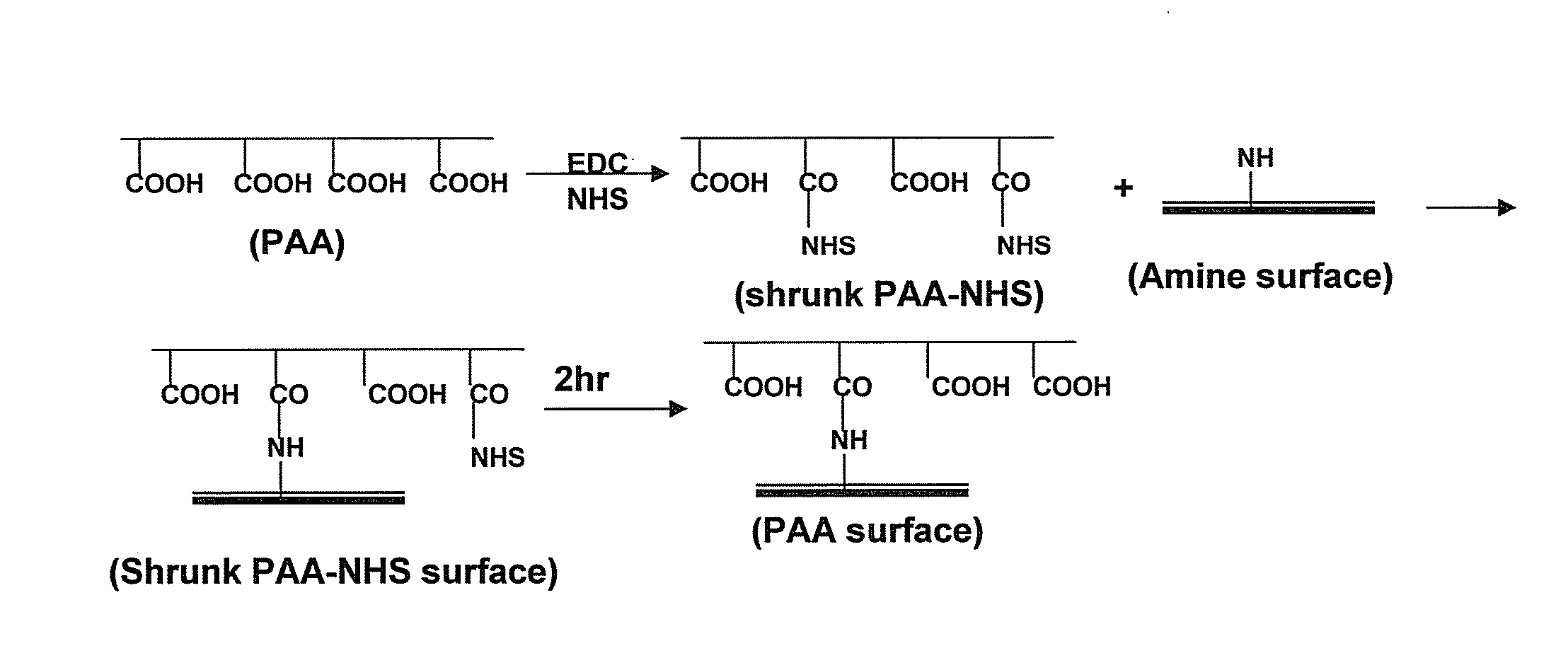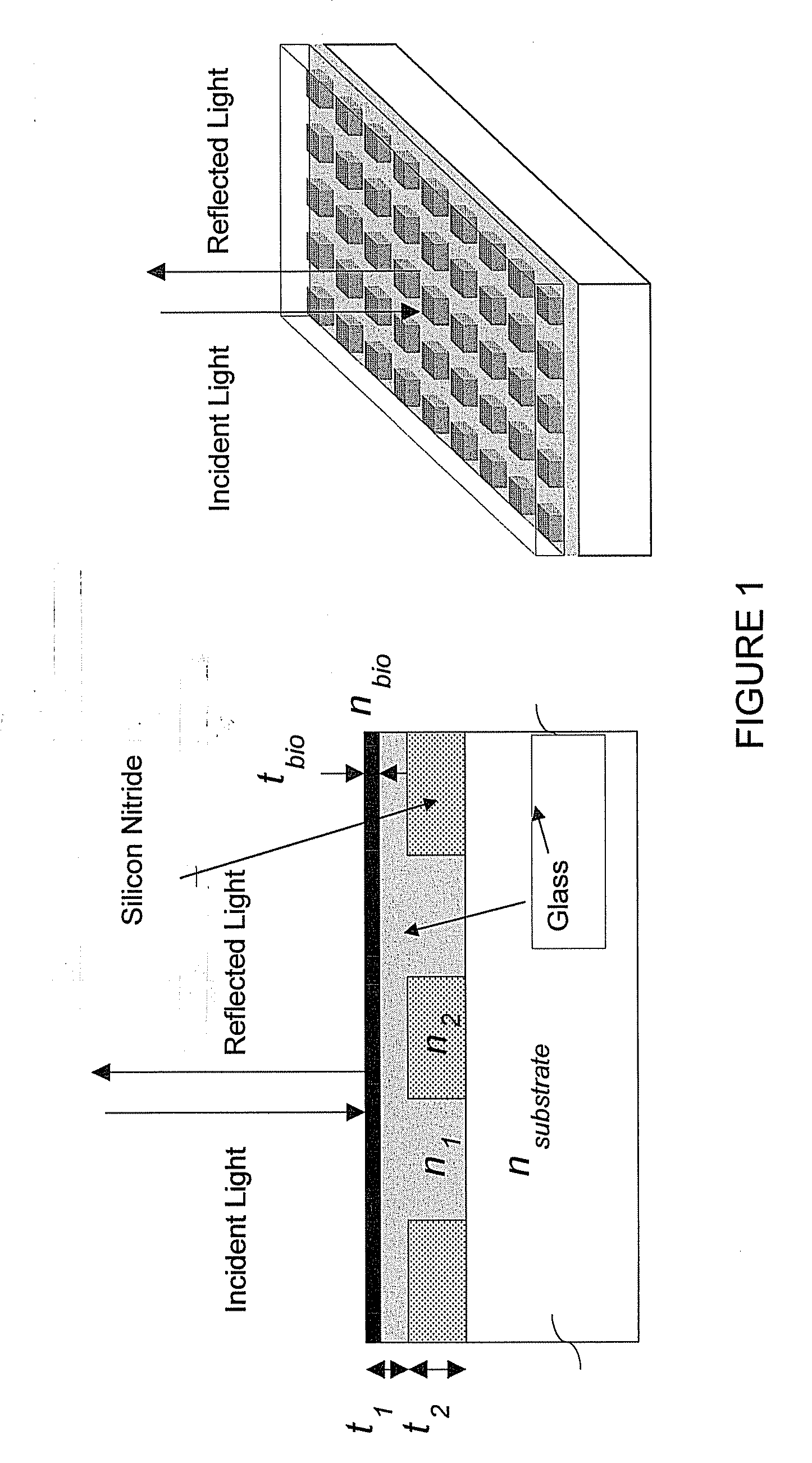High-density polymer surface coating to immobilize chemical or biological molecules
a polymer surface and high-density technology, applied in the field of high-density polymer surface coating to immobilize chemical or biological molecules, can solve the problems of affecting the conformation of molecules, unable to meet the requirements of chemical coating, etc., to achieve high primary amine density
- Summary
- Abstract
- Description
- Claims
- Application Information
AI Technical Summary
Benefits of technology
Problems solved by technology
Method used
Image
Examples
example 1
Fabrication of a SWS Biosensor
[0091]The detailed manufacture process of the SWS biosensor has been described previously. See, e.g., Cunningham B. et al., Sensor and Actuators B 6779, 1-6 (2002), incorporated herein by reference. Specifically, an optical-grade polymer film was used as a support of an SWS sensor. A UV-curable acrylic-based polymer coating was coated onto the film and replicated using a silicon mask that has 96 circles corresponding to the standard format of a 96-well micro-titer plate, which circles form an SWS structure. A UV lamp RC600, provided by Xenon Corporation (Woburn, Mass.), was used to cure the coating after the replication. Subsequently, a thin titanium dioxide layer and a silicone dioxide layer were deposited onto the top of the surface.
example 2
Attachment of Polyacrylic Acid (“PAA”) Polymers to Biosensor Surfaces
[0092]A plasma-treated biosensor surface was prepared by adding 0.25% 3-glycidoxypropyltrimethoxysilane in acetone using a Flexdrop precision reagent dispenser (Perkin Elmer), and incubating overnight at room temperature with 60% relative humidity. 5% purified polyvinyl amine (“PVA”) was added to the surfaces and allowed to incubate for 2 hr. Subsequently the surface was washed with DI water. Both 5% PAA (moleculer weight 100K) in water or 5% PAA (moleculer weight 250K) in water was mixed with an either equal volume of 1, 1 / 50, 1 / 20, 1 / 12, 1 / 8, or 1 / 6 dilution of 0.34M EDC and 10 mM NHS in water (EDC / NHS). 20 μl of each mixture was added into wells of the prepared surface and incubated for 2 hr, followed by a DI water wash.
[0093]The appearance of the PAA solutions after mixing with EDC / NHS but prior to addition to the surface is shown in the following table:
EDC / NHS dilution01 / 501 / 201 / 121 / 81 / 6PAA 250Kclearclearclear...
example 3
Creating a Low COOH Density Surface
[0095]In order to control the COOH density of the high-density polymer surfaces created in Example 2, a mixture of 15 μL of 1M ethanolamine with 15 μL of 0.034M / 1 mM EDC / NHS was added to the wells for 75 min to convert a specific number of COOH groups into OH groups, followed by a DI wash. Ethanolamine was added after the surfaces were stored for several hours, and therefore the PAA-NHS ester should have returned to PAA. The results of the test are shown in FIG. 4, expressed as delta PWV or PWV shift. As can be seen, the PAA that was attached to the surface using the “theta condition” reacted with more ethanolamine attested by the relative increase in the PWV shift.
PUM
| Property | Measurement | Unit |
|---|---|---|
| thickness | aaaaa | aaaaa |
| thickness | aaaaa | aaaaa |
| depth | aaaaa | aaaaa |
Abstract
Description
Claims
Application Information
 Login to View More
Login to View More - R&D
- Intellectual Property
- Life Sciences
- Materials
- Tech Scout
- Unparalleled Data Quality
- Higher Quality Content
- 60% Fewer Hallucinations
Browse by: Latest US Patents, China's latest patents, Technical Efficacy Thesaurus, Application Domain, Technology Topic, Popular Technical Reports.
© 2025 PatSnap. All rights reserved.Legal|Privacy policy|Modern Slavery Act Transparency Statement|Sitemap|About US| Contact US: help@patsnap.com



